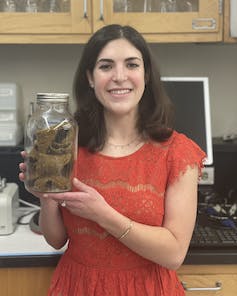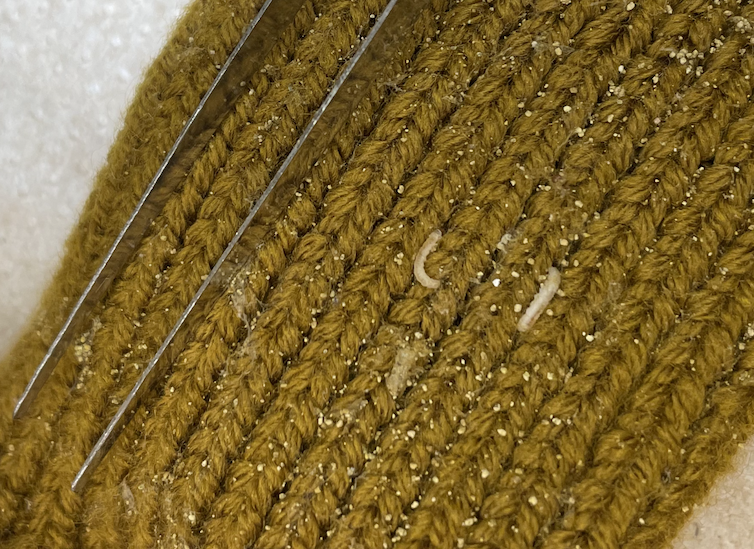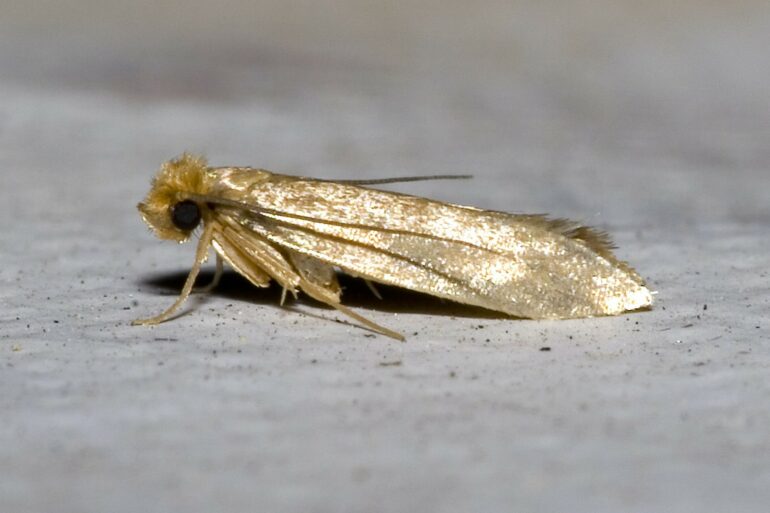Every day, I come into the lab to check the moth jar. The jar, which previously housed a liter of honey, now contains a multitude of small golden moths and their wriggly caterpillar offspring.

The author in the lab with her prized moth jar.
Isabel Novick, CC BY-ND
The founding population came from within my house – pests that fervently fed on my sweaters, rugs and horsehair plaster. When they emerge from my walls in the evenings, I chase them with zeal and catch them in jam jars. “Moth!” I shout, jumping up from the couch, knocking over whatever is in front of me. In the lab, I feed them clippings of a mohair sweater that shrank in the wash, which I soak in brewer’s yeast.
I’m a doctoral candidate studying the evolutionary relationships within the moth family Tineidae. I’m interested in how webbing clothes moths, Tineola bisselliella, have dispersed so widely and colonized our homes so readily. I am using a population genetics approach, examining the DNA of isolated populations of moths from all over the world. They eat crazy stuff. They live mostly indoors. How did this happen?
Resourceful, vigorous, tanklike eating machines
Webbing clothes moths are part of a distinctive, primordial lineage called the fungus moth family. These guys emerged long before more well-known species like silk moths. If you’re unlucky, you are already aware of the destruction they can wreak on sweaters, rugs and upholstery. But you many not realize how fascinating Tineidae are.

Tineola bisselliella larvae living it up on a scrap of sweater in the lab.
Isabel Novick, CC BY-ND
These moths can eat hair, skin and feathers, all of which comprise a protein called keratin. Keratin – the main ingredient in nails, hoofs and horns – is notoriously tough to digest. Biologists still aren’t sure how clothes moths can metabolize keratin, and this is something I aim to address in my research. One study posits that they harbor a microorganism in their gut that uses digestive enzymes to break down keratin for them.
However mysterious the process may be, their nutritional needs can be met with as little as a hairball and some vitamin B, which they can glean from sweat, pee and food stains. Not only that, but research suggests these moths somehow produce water as a byproduct of digesting keratin, so they can happily survive within the dry recesses of your home.
Incredibly, webbing clothes moths can safely digest poisonous heavy metals like arsenic, mercury and lead. They can easily chew through soft plastics and metabolize synthetic fabrics. They have been known to feast on mummified human remains and have even been a recognizable pest long enough to be mentioned in the Bible. They are so economically destructive that by the 1990s they were causing up to US$1 billion in damage per year in the U.S. alone.
This pest insect, over time, has hitchhiked all over the world. It can…



